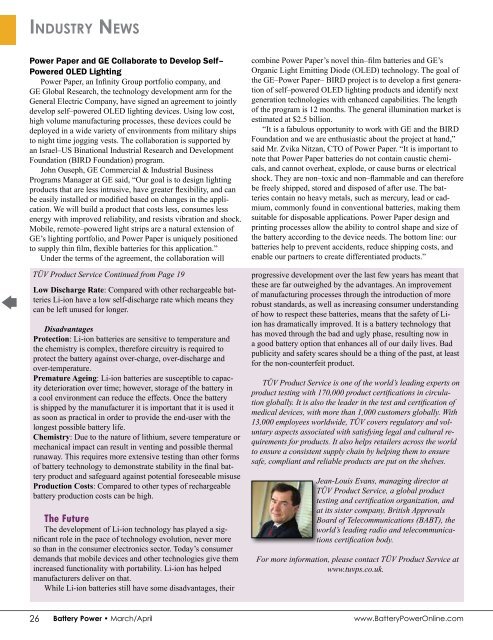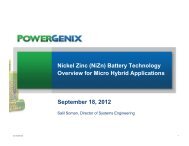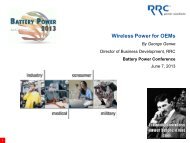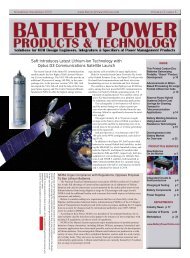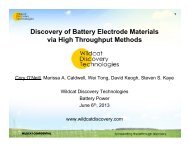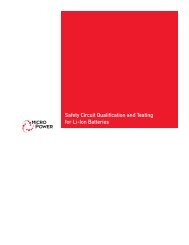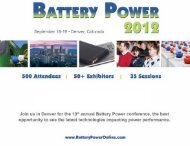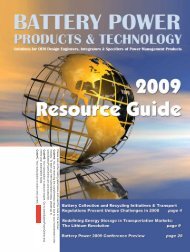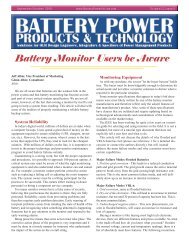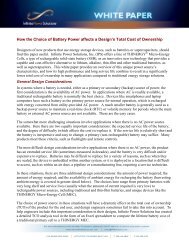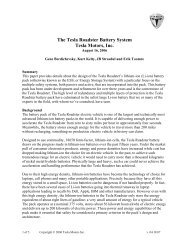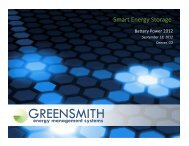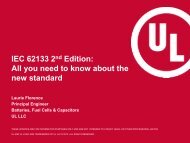Battery Management Systems - Battery Power Magazine
Battery Management Systems - Battery Power Magazine
Battery Management Systems - Battery Power Magazine
Create successful ePaper yourself
Turn your PDF publications into a flip-book with our unique Google optimized e-Paper software.
Industry News<br />
Industry News<br />
<strong>Power</strong> Paper and GE Collaborate to Develop Self–<br />
<strong>Power</strong>ed OLED Lighting<br />
<strong>Power</strong> Paper, an Infinity Group portfolio company, and<br />
GE Global Research, the technology development arm for the<br />
General Electric Company, have signed an agreement to jointly<br />
develop self–powered OLED lighting devices. Using low cost,<br />
high volume manufacturing processes, these devices could be<br />
deployed in a wide variety of environments from military ships<br />
to night time jogging vests. The collaboration is supported by<br />
an Israel–US Binational Industrial Research and Development<br />
Foundation (BIRD Foundation) program.<br />
John Ouseph, GE Commercial & Industrial Business<br />
Programs Manager at GE said, “Our goal is to design lighting<br />
products that are less intrusive, have greater flexibility, and can<br />
be easily installed or modified based on changes in the application.<br />
We will build a product that costs less, consumes less<br />
energy with improved reliability, and resists vibration and shock.<br />
Mobile, remote–powered light strips are a natural extension of<br />
GE’s lighting portfolio, and <strong>Power</strong> Paper is uniquely positioned<br />
to supply thin film, flexible batteries for this application.”<br />
Under the terms of the agreement, the collaboration will<br />
TÜV Product Service Continued from Page 19<br />
Low Discharge Rate: Compared with other rechargeable batteries<br />
Li-ion have a low self-discharge rate which means they<br />
can be left unused for longer.<br />
Disadvantages<br />
Protection: Li-ion batteries are sensitive to temperature and<br />
the chemistry is complex, therefore circuitry is required to<br />
protect the battery against over-charge, over-discharge and<br />
over-temperature.<br />
Premature Ageing: Li-ion batteries are susceptible to capacity<br />
deterioration over time; however, storage of the battery in<br />
a cool environment can reduce the effects. Once the battery<br />
is shipped by the manufacturer it is important that it is used it<br />
as soon as practical in order to provide the end-user with the<br />
longest possible battery life.<br />
Chemistry: Due to the nature of lithium, severe temperature or<br />
mechanical impact can result in venting and possible thermal<br />
runaway. This requires more extensive testing than other forms<br />
of battery technology to demonstrate stability in the final battery<br />
product and safeguard against potential foreseeable misuse<br />
Production Costs: Compared to other types of rechargeable<br />
battery production costs can be high.<br />
The Future<br />
The development of Li-ion technology has played a significant<br />
role in the pace of technology evolution, never more<br />
so than in the consumer electronics sector. Today’s consumer<br />
demands that mobile devices and other technologies give them<br />
increased functionality with portability. Li-ion has helped<br />
manufacturers deliver on that.<br />
While Li-ion batteries still have some disadvantages, their<br />
combine <strong>Power</strong> Paper’s novel thin–film batteries and GE’s<br />
Organic Light Emitting Diode (OLED) technology. The goal of<br />
the GE–<strong>Power</strong> Paper– BIRD project is to develop a first generation<br />
of self–powered OLED lighting products and identify next<br />
generation technologies with enhanced capabilities. The length<br />
of the program is 12 months. The general illumination market is<br />
estimated at $2.5 billion.<br />
“It is a fabulous opportunity to work with GE and the BIRD<br />
Foundation and we are enthusiastic about the project at hand,”<br />
said Mr. Zvika Nitzan, CTO of <strong>Power</strong> Paper. “It is important to<br />
note that <strong>Power</strong> Paper batteries do not contain caustic chemicals,<br />
and cannot overheat, explode, or cause burns or electrical<br />
shock. They are non–toxic and non–flammable and can therefore<br />
be freely shipped, stored and disposed of after use. The batteries<br />
contain no heavy metals, such as mercury, lead or cadmium,<br />
commonly found in conventional batteries, making them<br />
suitable for disposable applications. <strong>Power</strong> Paper design and<br />
printing processes allow the ability to control shape and size of<br />
the battery according to the device needs. The bottom line: our<br />
batteries help to prevent accidents, reduce shipping costs, and<br />
enable our partners to create differentiated products.”<br />
progressive development over the last few years has meant that<br />
these are far outweighed by the advantages. An improvement<br />
of manufacturing processes through the introduction of more<br />
robust standards, as well as increasing consumer understanding<br />
of how to respect these batteries, means that the safety of Liion<br />
has dramatically improved. It is a battery technology that<br />
has moved through the bad and ugly phase, resulting now in<br />
a good battery option that enhances all of our daily lives. Bad<br />
publicity and safety scares should be a thing of the past, at least<br />
for the non-counterfeit product.<br />
TÜV Product Service is one of the world’s leading experts on<br />
product testing with 170,000 product certifications in circulation<br />
globally. It is also the leader in the test and certification of<br />
medical devices, with more than 1,000 customers globally. With<br />
13,000 employees worldwide, TÜV covers regulatory and voluntary<br />
aspects associated with satisfying legal and cultural requirements<br />
for products. It also helps retailers across the world<br />
to ensure a consistent supply chain by helping them to ensure<br />
safe, compliant and reliable products are put on the shelves.<br />
Jean-Louis Evans, managing director at<br />
TÜV Product Service, a global product<br />
testing and certification organization, and<br />
at its sister company, British Approvals<br />
Board of Telecommunications (BABT), the<br />
world’s leading radio and telecommunications<br />
certification body.<br />
For more information, please contact TÜV Product Service at<br />
www.tuvps.co.uk.<br />
Sandia’s <strong>Battery</strong> Abuse Testing Laboratory Awarded<br />
$4.2 Million in Stimulus Funds<br />
Sandia National Laboratories will use $4.2 million in<br />
American Recovery and Reinvestment Act funds to modify and<br />
enhance its existing <strong>Battery</strong> Abuse Testing Laboratory (BAT-<br />
Lab), with the goal of developing low-cost batteries for electric<br />
and plug-in hybrid electric vehicles.<br />
Sandia’s BATLab is internationally recognized as a leader<br />
in the field of battery testing to ensure they meet real-world<br />
performance requirements. The tests help to determine how<br />
much abuse lithium ion batteries can safely handle, including<br />
being crushed, pounded with nails and heated to boiling hot temperatures.<br />
Sandia tests<br />
everything from regular<br />
small cells about<br />
the size of a laptop<br />
computer battery up to<br />
full-sized modules and<br />
packs weighing several<br />
hundred pounds<br />
for hybrid vehicles.<br />
Sandia researcher Pete Roth examines<br />
a lithium-ion battery before dismantling<br />
it for testing in the chamber behind him.<br />
Photo by Randy Montoya<br />
The $4.2 million<br />
in funding is part of<br />
a $104.7 million economic<br />
stimulus package to further develop the nation’s efforts<br />
in clean energy and efficient technologies across seven DOE<br />
national laboratories.<br />
The nation’s first full-scale debut of electric cars that can<br />
run up to 40 miles on a single charge is expected late next year,<br />
and Sandia has played an instrumental role in ensuring the<br />
safety and reliability of the batteries that power those vehicles.<br />
The DOE-funded FreedomCAR program turned to Sandia to<br />
investigate the possibility of safely using lithium-ion batteries,<br />
which have more power and weigh less than the nickel-metal<br />
hydride batteries currently being used in hybrid vehicles. But<br />
before lithium-ion batteries could be placed in vehicles, extensive<br />
safety tests needed to take place. With the recent stimulus<br />
funds, the BATLab will be able to greatly increase the number<br />
of tests it does.<br />
“The equipment and facilities that we currently have allow<br />
us to do only one test at a time, so our throughput has been<br />
somewhat limited,” said Pete Roth, lead researcher for Sandia’s<br />
FreedomCAR program. “The new equipment and upgrades<br />
that we will be able to implement will enhance the amount and<br />
range of testing and diagnostics that we can do, and we expect<br />
to at least be able to double our throughput.” Those upgrades<br />
include fire suppression, improved lighting and advanced<br />
electrical systems, in addition to new software and analytical<br />
26 <strong>Battery</strong> <strong>Power</strong> • March/April<br />
www.<strong>Battery</strong><strong>Power</strong>Online.com<br />
www.<strong>Battery</strong><strong>Power</strong>Online.com March/April • <strong>Battery</strong> <strong>Power</strong> 27


